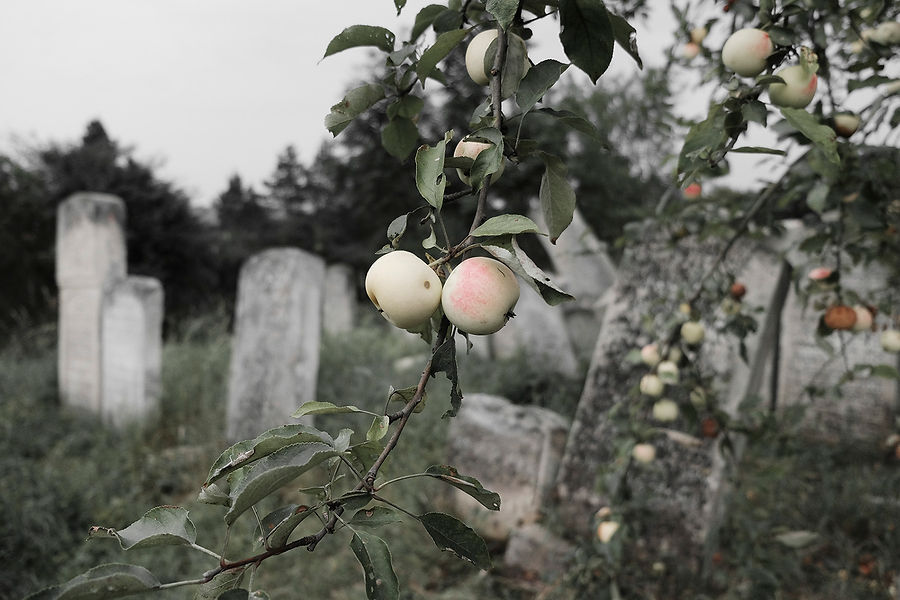A journey through Shtetls in Western Ukraine
Photographs by Eddie Gerald
Back in the days when Jews could travel without having to go anywhere - one minute a house was in Poland, the next in Russia - they lived in places called shtetls, defined neither by physical size nor population, possessing mysterious features both urban and rural. Though Christians lived there too, the shtetl tilted spiritually toward Jerusalem, while performing economic services for the Slavic society to which it also belonged, giving it an Eastern European character all its own. Its amorphous nature has made it the subject of easy mythologizing, so that it often pops up in the American imagination as a kind of Jewish Brigadoon where all the villagers are singing, unless they are running from a pogrom.
Yohanan Petrovsky-Shtern, a professor of Jewish studies at Northwestern University, would like us to view the shtetl as neither the spiritual apotheosis nor the physical nadir of Jewish exile. For this he has to do some digging, because while the giants of Yiddish literature were around to record the shtetl’s gasping decline in the late 19th and early 20th centuries, its “golden age” — which he puts roughly between the 1790s and the 1840s — is a tale that lives mainly in the archives.
“The Golden Age Shtetl” focuses on three provinces in central Ukraine. It is populated by “Jewish tavernkeepers, international smugglers, members of Slavic gangs, traders in colonial commodities, disloyal husbands and avid readers of books.” Determined to keep these unsung heroes from remaining the pale ink in someone else’s palimpsest, Petrovsky-Shtern is not beyond his own mythologizing impulses. His shtetl-folk possess “the mental qualities of urban dwellers and the corporeal capabilities of peasants.”
He mythologizes himself a little, too, telling us that in order to get his hands on hidden documents, “I sometimes disguised myself as a Ukrainian clerk, a Soviet speleologist and a polar explorer.” One feels the author, who grew up in Ukraine, imagining himself as one of those Jewish smugglers he writes about, men who could “handle a lance to intimidate the mounted border patrol; a sword if they had to engage the guards in a fight and pistols to protect their booty from the Cossack guards.”
The shtetl was home to two-thirds of Eastern Europe's Jews in the 18th and 19th centuries, yet it has long been one of the most misunderstood chapters of the Jewish experience. Challenging popular misconceptions of the shtetl as an isolated, ramshackle Jewish village stricken by poverty and pogroms, Professor Petrovsky-Shtern argues that, in its heyday from the 1790s-1840s, the shtetl was a thriving Jewish community, as vibrant as any in Europe. His book presents the shtetl as a Polish private town belonging to a Catholic magnate, administratively run by the tsarist empire, yet economically driven by Jews. Jews turned the shtetl marketplace into a supermarket. They smuggled and drank vodka, seeing in both actions a moment of freedom. They built houses that served as urban stores and village barns and purchased Hebrew books they could not understand. In addition, they surrounded themselves with the symbols of the Holy Land and Jerusalem, although they were not actually planning to leave for Palestine.

An Ukrainian guide holds an old photo of a synagogue built in 1909, established on the basis of a former Hasidic kloyz (1870) in the city of Chortkiv which was once home to a large Jewish community and was annihilated by the Germans during the Second World War in Ternopil Oblast (province) in western Ukraine.

The window of an old synagogue built in 1909, established on the basis of a former Hasidic kloyz (1870) in the city of Chortkiv which was once home to a large Jewish community and was annihilated by the Germans during the Second World War in Ternopil Oblast (province) in western Ukraine.

The Star of David seen over huge concrete slab marking mass grave of Jews killed by Germans during the second world war in the forest of Bronytsya, a small village north of the city of Drohobych in Lviv Oblast, Ukraine.

An Ukrainian guide holds an old photo of a synagogue built in 1909, established on the basis of a former Hasidic kloyz (1870) in the city of Chortkiv which was once home to a large Jewish community and was annihilated by the Germans during the Second World War in Ternopil Oblast (province) in western Ukraine.
Text by Yohanan Petrovsky-Shtern a historian, philologist and essayist, noted in particular for his studies of the institution of Cantonism, His book The Golden Age Shtetl is a colorful, exhaustively researched study of a period when Jews were fully at home in shtetl life.
Photo essay was conducted with the help of ROOTKA a Polish agency which specialize in the field of Jewish heritage and history and also offer the service of genealogical research for people interested in finding out more about their own family’s history.
